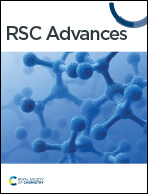Magnetic-assisted preparation and performance control of Fe3O4/PVDF gradient magnetic composites†
Abstract
In this study, a gradient Fe3O4/PVDF magnetic composite was prepared using magnetic-assisted template filling technology. The purpose of this study was to explore a simple, economical, and scalable method for preparing gradient magnetic composites. The structure and magnetic performance of the composite were studied, and the parameters that influenced the gradient magnetic properties of the material, such as magnetic intensity, magnet spacing, initial content of magnetic particles, and magnet movement speed, were investigated. The results showed that increasing magnetic intensity during the template filling process enhanced the electromagnetic force on the magnetic particles, resulting in a greater magnetic particle content gradient. The variation in magnet spacing affected the spatial magnetic field distribution, and increasing the magnet spacing increased the gradient of the magnetic intensity in the y-direction. The magnetic gradient of the Fe3O4/PVDF composite first decreased and then increased as the magnet spacing increased. Increasing the magnet movement speed enhanced the gradient of the magnetic intensity in the y-component but shortened the duration of the electromagnetic force. By adjusting these parameters, it is possible to regulate the structural and magnetic properties of the Fe3O4/PVDF composite. This work may have implications for research and application in related fields and promote the development and innovation of magnetic materials.



 Please wait while we load your content...
Please wait while we load your content...